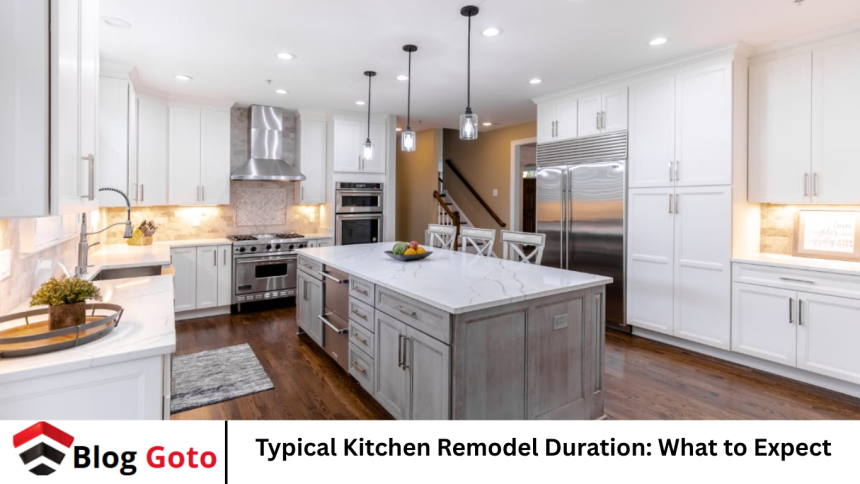A kitchen remodel is one of the most popular—and rewarding—home renovation projects. Whether you’re upgrading outdated cabinetry, improving layout efficiency, or completely transforming the heart of your home, remodeling your kitchen can significantly enhance both function and aesthetics.
Remodeling a kitchen is one of the most exciting yet challenging home improvement projects you can undertake. It’s where design meets function, and the transformation often breathes new life into the heart of the home. But one question looms large for every homeowner: How long does a kitchen remodel actually take?
The truth is, there’s no one-size-fits-all timeline. Kitchen renovations can last anywhere from a few weeks to several months, depending on the project’s scope, planning, and unforeseen issues. This article breaks down the average kitchen remodel timeline, factors that influence the duration, and expert tips to keep your renovation on track.
More Read: 7 Designer-Backed Reasons Your Home Feels Outdated
Planning Phase (2–6 Weeks)
Before any demolition begins, the planning phase lays the foundation for a smooth kitchen remodel. This stage involves:
- Setting a budget
- Hiring a contractor or designer
- Deciding on layout changes
- Selecting materials and appliances
- Obtaining necessary permits
Why It Takes Time:
Many homeowners underestimate how long planning takes. If you’re working with a professional designer or contractor, it can take a few weeks just to finalize drawings, get quotes, and make material selections. Delays often occur due to indecisiveness or limited availability of preferred materials.
Tips to Stay on Schedule:
- Decide your must-haves early.
- Finalize material and appliance choices before work begins.
- Work with experienced professionals who can foresee issues in advance.
Ordering Materials and Appliances (2–8 Weeks)
Once the design is approved, it’s time to order all the materials, fixtures, and appliances. This includes:
- Cabinets
- Countertops
- Backsplash tiles
- Flooring
- Lighting fixtures
- Sink and faucet
- Major appliances
Why It Takes Time:
Lead times can vary greatly. Custom cabinets can take 6–10 weeks to arrive, while some appliances may be backordered due to supply chain disruptions. The entire remodel may pause if critical components haven’t arrived.
Tips to Stay on Schedule:
- Order materials as soon as possible.
- Ask your contractor to suggest alternatives with shorter lead times.
- Be flexible with brands and finishes.
Demolition (2–5 Days)
With all the planning done and materials on order, the physical work begins. The old kitchen is stripped away—cabinets removed, countertops demolished, appliances taken out, and possibly even flooring and walls.
What Affects Demolition Time:
- Kitchen size
- Amount of structural work
- Whether any hidden issues (like mold or rot) are discovered
Demolition can reveal surprises that delay the schedule, such as water damage, pest infestations, or outdated wiring.
Tips to Stay on Schedule:
- Conduct a pre-renovation inspection to uncover issues in advance.
- Have a contingency fund to address problems quickly.
Structural Work, Plumbing, and Electrical (1–3 Weeks)
This is the most technical part of the remodel. Depending on how much you’re changing, it may involve:
- Moving or removing walls
- Installing or relocating plumbing and gas lines
- Upgrading electrical panels or wiring
- Adding lighting fixtures or outlets
Why It Takes Time:
If you’re simply replacing appliances without moving anything, this phase will be short. But if you’re relocating your sink or stove, you’ll need licensed tradespeople to rework plumbing and electrical systems.
Inspections may also be required after this stage, depending on your local regulations.
Tips to Stay on Schedule:
- Hire licensed, reliable professionals.
- Ensure all required permits are secured ahead of time.
- Be available for inspections to avoid rescheduling delays.
Flooring and Walls (1–5 Days)
Next comes the installation of new flooring, drywall, and paint. This step sets the visual tone for your new kitchen and is usually quicker than other phases.
What Affects This Timeline:
- Type of flooring (tile takes longer than laminate)
- Drywall curing and painting time
- Room size
Tips to Stay on Schedule:
- Choose materials that don’t require long curing times.
- Make paint color decisions in advance.
Cabinetry and Countertops (1–2 Weeks)
Once the walls and floors are ready, cabinet installation begins. This step is critical because the countertops can’t be measured and fabricated until cabinets are in place.
Why Countertops Take Longer:
Most countertops are custom-cut to fit. After templating (measuring), fabrication usually takes 7–10 business days. Then comes the actual installation.
Tips to Stay on Schedule:
- Ensure your cabinet layout is finalized early to avoid remeasurement.
- Ask your fabricator for accurate timelines and book installation dates in advance.
Finishing Touches (1–2 Weeks)
The final stretch includes:
- Installing the backsplash
- Hooking up appliances
- Connecting plumbing and lighting fixtures
- Installing hardware (knobs, handles)
- Touch-up paint and caulking
This stage may feel slow because the big visual changes are done, but don’t rush it. The details matter.
Tips to Stay on Schedule:
- Be present for appliance delivery and final installations.
- Do a walkthrough with your contractor to create a punch list.
- Ensure all trades are scheduled efficiently.
Factors That Can Extend Your Remodel Timeline
Even with careful planning, these common factors can cause delays:
- Permit Delays – Some cities have backlogs or require inspections between phases.
- Backordered Items – Especially custom or specialty products.
- Change Orders – Making design changes mid-project slows everything down.
- Contractor Scheduling Conflicts – Especially during busy seasons.
- Structural Surprises – Hidden damage behind walls or under floors.
- Weather – In some cases, bad weather can delay deliveries or contractor schedules.
Tips to Keep Your Kitchen Remodel on Track
- Stick to the plan: Changing your mind mid-project almost always causes delays.
- Communicate frequently: Stay in touch with your contractor or project manager.
- Keep a written timeline: Track what’s supposed to happen and when.
- Prepare a temporary kitchen: The smoother your daily life is, the more patient you’ll be.
- Add a buffer: Expect at least 10–20% extra time in your schedule just in case.
When Is the Best Time to Remodel a Kitchen?
The ideal time varies based on your lifestyle and location. Many homeowners choose spring or summer because it’s easier to grill outdoors or take vacations during the disruption. However, contractors may be more available during slower seasons like late fall or winter.
Frequently Asked Question
What is the average time to remodel a small kitchen?
A small kitchen remodel typically takes 4 to 8 weeks, depending on the complexity and whether major systems like plumbing or electrical need updating.
Can a kitchen remodel be done in 4 weeks?
Yes—but only for minor remodels that involve surface updates like painting, new appliances, and refacing cabinets. A full gut-and-replace remodel usually takes longer.
How long should I plan to live without a functioning kitchen?
Plan to be without a working kitchen for 6–8 weeks in a full remodel. Set up a temporary kitchen with essentials like a microwave, coffee maker, and fridge in another room.
What causes the most delays in a kitchen remodel?
Delays often stem from late material deliveries, design changes, or hidden issues like outdated wiring or mold. Custom cabinetry also has long lead times.
Do I need to get permits for a kitchen remodel?
Yes, for any work involving plumbing, electrical, or structural changes, you’ll need permits. The approval process can take anywhere from a few days to a few weeks.
Should I stay in my home during the remodel?
If possible, yes—but be prepared for noise, dust, and inconvenience. Some homeowners choose to stay elsewhere temporarily during demolition or countertop installation.
How do I know if my contractor is keeping the project on schedule?
Ask for a written timeline with milestones. Regular check-ins and progress reports will help you spot issues early and keep things moving smoothly.
Conclusion
A kitchen remodel is a significant undertaking that requires time, patience, and thoughtful planning. While the average project lasts between 6 and 16 weeks, many factors—from design complexity to contractor availability—can influence the timeline. The key to a successful and on-time remodel is preparation. Make decisions early, stick to your plan, and maintain good communication with your contractor. With a realistic timeline and a flexible mindset, you’ll soon enjoy a beautiful, functional kitchen that was worth every minute.











